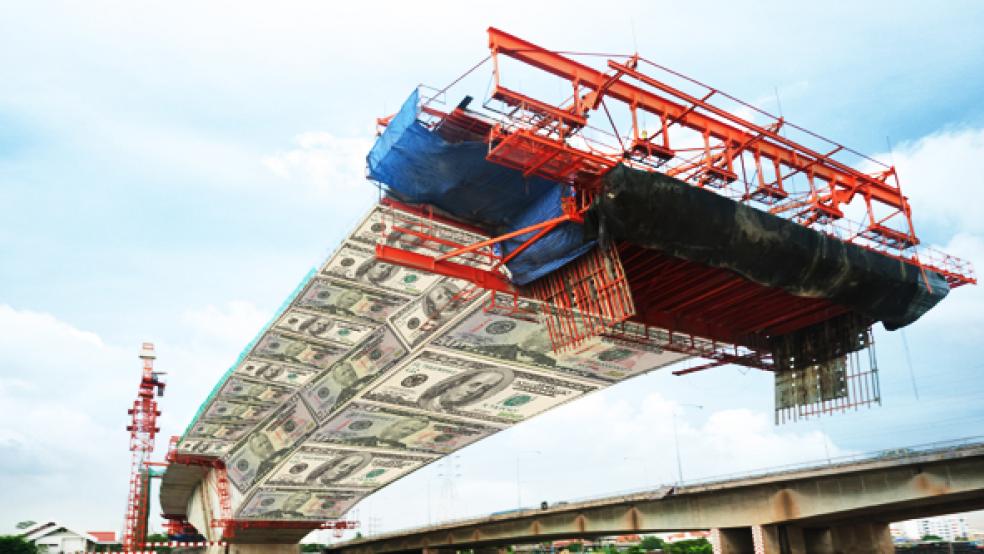A rare point of agreement between President-Elect Trump and Congressional Democrats is that America has an infrastructure deficit: The nation’s transportation, power, water and sewerage facilities are too often outdated and unable to reliably serve a growing population. But while the diagnosis crosses party lines, solutions are more controversial. Democrats may not be too worried about the recent increase in federal deficits, but Republicans who have made an issue of the national debt will be reluctant to produce more red ink. Likewise, tax increases to pay for new federal construction spending are off the table under Trump and a Republican-controlled Congress.
So it may be politically difficult to find federal funds for an ambitious infrastructure initiative. But, outside the federal government, a large pot of money is available to finance new projects. Although most public employee pension plans are underfunded, they have, in aggregate, $3.8 trillion of assets. Most of this money is invested in bonds and stocks, but these asset classes have drawbacks in the current environment. Bond yields are near historical lows, well below the levels needed to provide the 7-plus percent returns projected in pension plan actuarial forecasts. Stocks have been doing well, but after a seven-year bull market that has witnessed a tripling of the Dow Jones Industrial Average, U.S. equities have major downside risk.
Related: Trump Proposes $1 Trillion for Infrastructure Without Raising Taxes
If infrastructure investments could generate reasonable and relatively safe returns for public pension funds, they would provide an intriguing investment alternative. In a new California Policy Center study, my co-authors and I outline infrastructure investment alternatives for pension funds and private investors. We also discuss policy changes needed to encourage these investors to help rebuild America.
Let’s be clear on how this option differs from federal funding. Politicians often call federal spending an investment, but that’s just rhetoric. Real investors expect financial returns, in the form of interest, dividends and/or capital appreciation. If the federal government spends money to subsidize state freeways, it won’t see a financial return on its “investment.” There is no stream of toll revenues to provide dividends, nor does a freeway have any resale value.
While drivers dislike tolls, the ability to collect such revenue transforms highway spending into an investment — one that may be attractive to pension funds. Toll revenues also provide road operators with both the incentive and the resources needed to maintain and improve their highways. If a toll road becomes congested or potholed, drivers may look around for alternatives, shrinking toll income available to investors. To avoid this situation, toll road operators may be expected to resurface their highways more frequently and to add new lanes more quickly.
Related: $1.7 Trillion in Unfunded State Pensions Is Squeezing Vital Public Programs
In Canada, Europe and Australia, it is common for pension funds to invest in highways and other infrastructure. In 2011, for example, an Australian pension fund took over the Queensland Motorway. Since then, it has improved the highway and made a large profit. Earlier this year, an Australian-led consortium bought the Indiana Toll Road (a segment of I-90) out of bankruptcy, with the California Public Employees Retirement System (CalPERS) taking a 10 percent share.
One might wonder why a California pension fund would invest in an Indiana toll road rather than a California project, but there are good reasons. First, California — famous for its freeways — doesn’t have many toll road investment options. More importantly, investing in-state could result in political considerations supplanting proper financial analysis. For example, Gov. Jerry Brown has sought private investments in California’s high-speed rail project. But that initiative has questionable revenue projections and seems likely to suffer delays and cost overruns. If CalPERS were to invest in the high-speed rail project to placate elected officials, it could make a bad deal for the state’s pensioners and taxpayers by taking on a low-quality investment.
One way to keep politics out of pension infrastructure investment decisions, reduce risk and still keep some money local, is to create a nationwide pool of pension assets available for infrastructure projects. Such a pool would professionally manage funds provided by pension systems in multiple states. Pool managers would be insulated from in-state political considerations because their assets would come from geographically diverse sources. Also, because the pool would invest in a diversified portfolio of infrastructure projects, it would be less vulnerable to large losses.
Related: 4 Reasons Trump’s Economic Policies Would Be a Disaster
Other policies may need to change before U.S. pension infrastructure investment pools can become viable. Too many of our bond-funded roads and utilities are free to use or are heavily discounted through tax subsidies. In the case of highways, we should be looking to toll revenues rather than the gas tax, which will become less effective as electric vehicles become more common. In California, which faces an ongoing drought, a reluctance to charge higher water rates limits opportunities to reuse waste water and build desalination plants. Recycling sewer water and removing salt from ocean water are much more expensive than capturing rainwater, but watersheds serving the state’s heavily populated coastal areas no longer receive sufficient supplies of rainwater on a reliable basis.
In some cases, government can encourage pension fund and private investments by offering financial guarantees and other credit enhancements, but these arrangements need to be carefully structured to avoid allegations and appearances of crony capitalism. Another key reform would involve expediting project approvals. In Orange County, south of Los Angeles, we found one desalination project that has been under review for 18 years. It’s hard to imagine investors parking their money for such a long period of time.
America needs to renew its infrastructure. Pension systems have the capital needed to fund these essential investments. With some attitudinal and policy changes, we can channel their resources to the task of rebuilding our country.






